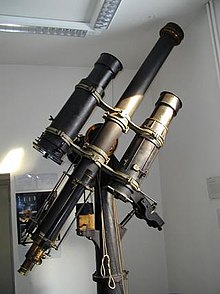Double astrograph
The double astrograph is a special, powerful double telescope for scientific astrophotography that was developed at the end of the 19th century. A long focal length guide telescope and two shorter focal length photo telescopes ( astrographs ) are mounted on a common equatorial mount .
The double design of the photo telescope can, on the one hand, accelerate the long exposure of the sky and, on the other hand, allow simultaneous recording in different color areas .
Max Wolf developed one of the first double astrographs around 1890 for his private observatory in Heidelberg. Thanks to groundbreaking discoveries of galactic dust nebulae , Wolf succeeded a few years later in winning the American philanthropist Catherine Wolfe Bruce (1816–1900) to sponsor a three times larger instrument for the Heidelberg-Königstuhl State Observatory. The two cameras have an aperture of 40 cm and a focal length of 2 meters. Bruce funded a similar instrument for the Yerkes Observatory in the United States.
Double astrographs were widespread until the 1970s, but have lost their importance today due to the shorter exposure times of CCD sensors and space telescopes . Well-known manufacturers in Europe were u. a. Zeiss and Askania .

